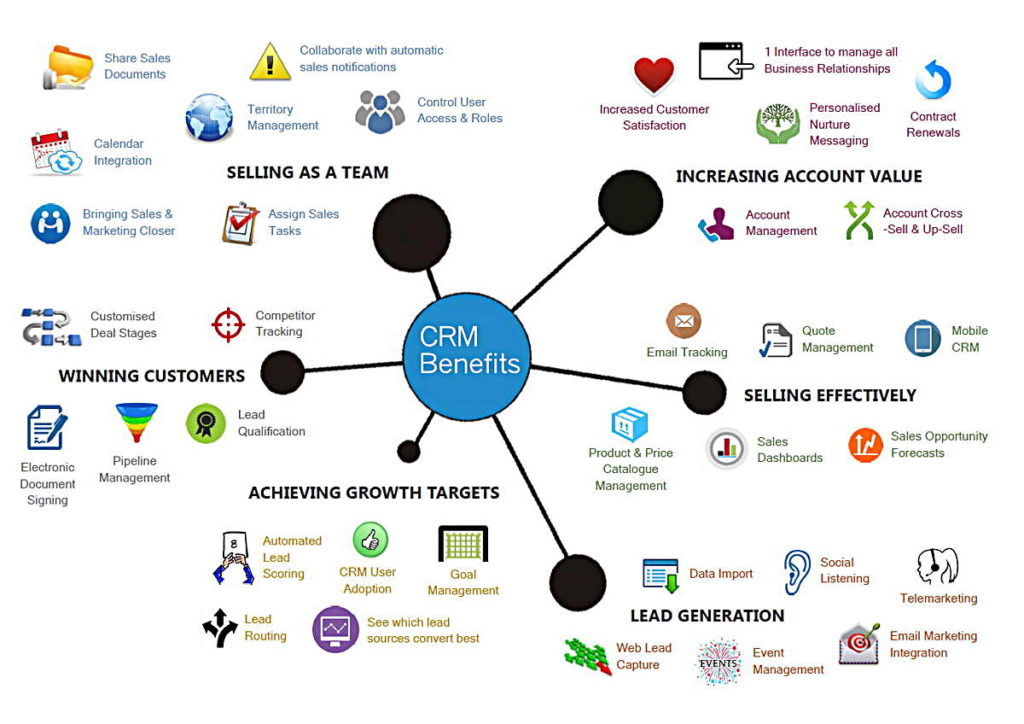Delivery Services
CRM Implementation
Companies realize the importance of becoming more customer‐centric in today’s global economy. As successful firms such as Amazon rise by prioritizing customers, other firms are looking for the right tools that can pull in authentic customer knowledge then push back out relevant information to make their products and services more valuable. At 9Nation, we not only review these applications, but manage the entire implementation process so the tools deliver true value.
Customers expect their services to be personalized and available on all platforms. These demands have in turn ensured the rapid growth of CRM, especially as a cloud-based solution. In fact, CRM software has become the biggest global software market, and that growth will accelerate over the next five years. By 2025 CRM products could bring in $80 to 100 billion in revenues. Firms that don’t have access customer data in real-time, on any device won’t be able to compete.
The shift to the best of breed systems such as Salesforce or Microsoft Dynamics, requires a rapid deployment that involves new technologies, processes and positions. The implementation and deployment requires the right planning and team that have the experience to gather requirements, configure a new solution, and provide an adoption strategy with the optimal communications and training. This is always easier said than done.

Here are elements of success for a CRM implementation:
1. Initiate a CRM Selection Process
Depending on your industry, organization size, and goals, there are dozens of CRM packages that can assist nearly any business. In fact, with so many options, it is difficult to decide where to begin. Our view is to first look to similar organizations that have gone through the process of selecting and implementation CRM software. There is no reason to reinvent the wheel or waste resources when others have already done the work for you. We will often set up client / peer discussion groups as well as one-on-one reference checks with these companies to get the critical information to assist with the decision.
2. Set up a Project Team to oversee the Initiation and Execution Phases of a CRM implementation
A CRM implementation usually takes 4-6 months, and can be both time-consuming and costly. Often many work-streams are being done simultaneously and you need a point person to track all activities as well as keep the vendors in check. Usual tasks include developing and signing a Statement of Work, building a project plan that can be agreed to by all parties, establishing the governance model, and managing the resources and budget.
3. Focus on the details during Contracting & Licensing
To develop a system that works for your firm, you need to clearly articulate all of your requirements. This includes the current and future state based off your company’s growth strategy. Be sure to know your value to the CRM provider before starting negotiations. If you are large enough, or can be leveraged as a reference for them, you may be able to ask for more than their “standard” agreements. If possible, know what areas of the implementation and operation have the highest margins to negotiate better. For example, if you are looking to add a couple dozen custom fields to track your customers, and the vendor can easily modify their software to accommodate without paying for a lot of development work, do not let them increase the overall cost. Finally, establish a matrix of responsibilities for each party. Who will do the data migration work? Who will sign-off on testing? Will the vendor assist with all third party integrations?
4. Review customizations continuously
Through the requirements and development phases, communication is critical not only with the Analysts that are documenting the needs, but the developers who are making the configuration updates. If you can catch issues early on in the process, it will save time and budget rather than waiting until the formal testing phase. Further, you should prioritize the change requests so developers don’t waste time on areas of the system that don’t add much value to our organization. Each week the vendor should document and demonstrate the features that were worked on – this keeps the vendor honest and helps manage to a schedule.
5. Develop a comprehensive data migration strategy
Time after time, clients attempt to build a new CRM system by downloading all their employee contacts and opportunities from multiple legacy CRM systems without a game-plan. The thought process is data can be easily filtered in the future, but clients don’t want to lose information. The problem is the data is “dirty” with multiple versions of the same contacts and customers. Viewing it in the new system is a frustrating experience and instantly creates a negative reaction from the start. Instead migration tools should be leveraged prior to initial data imports. Data rules should be global across all regions so the database won’t break-off into various instances.
6. Agree on an adoption strategy based on the organization’s culture
No matter how great the product, accept that a large group of users will require multiple exposures to documentation and training in order to gain the critical skills to succeed with your new product(s). Some organizations benefit from a high degree of communications, some like to use rewards, while others punish users for refusing to hop aboard the new train – there is really no one way that works for everyone, just make sure there is a strategy in place.
We can bring a combination of experience, knowledge and tools customized for large-scale implemenations. By combining these with best practices learned over twenty years, the benefits realized outweigh the out-of-pocket investment.
